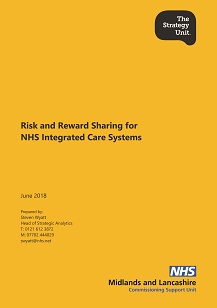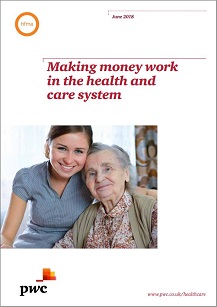Capitation budgets: getting the balance right
Accountable care organisations (ACOs) and accountable care systems (ACSs) in the NHS were remarketed earlier this year as integrated care organisations and systems (ICSs). This was in part to counter confusion with US-based ACOs and concerns that moves to integrate care would lead to US-style privatisation of NHS services.
The Commons Health and Social Care Committee has helpfully debunked this, which it is hoped will enable health systems around England to focus on more productive issues when engaging with their populations about integration plans.
But, while the comparison has not been helpful, there are some things the NHS can learn from US ACOs, set up in 2012 as part of President Obama’s health reforms to improve care and reduce growing costs.
In particular, a new report from NHS consultancy the Strategy Unit – hosted by the Midlands and Lancashire Commissioning Support Unit – suggests there are lessons to learn from the US’s experience with risk and reward sharing as part of payment approaches.
Risk and reward sharing for NHS integrated care systems warns that while risk and reward sharing appears a simple and attractive concept, robust schemes are likely to be complex, require careful construction and should be tested and evaluated. The report focuses on mechanisms to allow commissioners share the risks of cost rises related to growing demand – and to reward providers where they help offset these demands.
There is a wide recognition that the NHS needs to change its models of care. Even with promised increased funding, a growing and ageing population with higher levels of long-term conditions means the service needs to focus more on prevention, earlier intervention and supporting people to manage their conditions better in the community.
Existing payment systems – using fee-for-service models or tariffs for acute services and block contracts for mental health and community activity – do not support this transformation. Instead, capitation-based models are seen as a better way forward. And the report suggests risk and reward sharing offers a transition to capitated contracts or could provide a longer term payment mechanism alongside capitated budgets.
In the US, 561 ACOs hold a contract with the Centers for Medicare and Medicaid Services – the US government funded health insurance programmes for elderly people and those with limited resources. Together, these ACOs serve 10.5 million patients, making them substantially smaller than the new and future ICSs in England, which have or are expected to evolve from the existing 44 sustainability and transformation partnerships.
US ACOs’ budgets are based on expected annual spend and they sign up to one of three risk sharing tracks. Track 1 is an extreme asymmetric or one-sided arrangement, which does not expose the ACO to any risk. If its priced activity exceeds expected levels, the commissioner pays at the unit price specified in the contract. But if savings are made, ACOs can receive up to 50% of the savings. However, while this encourages ACO sign-up to the programme, they can only be on this track for a maximum of two three-year contracts. In tracks 2 and 3, ACOs can benefit from a higher proportion of savings, but also share in losses associated with cost over-runs.
Performance against a series of quality measures also influences the level of savings or losses the ACO can share in. And there are overall capping levels for the savings that can be made as a proportion of total expenditure (10%, 20% and 30%) for the three tracks.
In January, some 91% of the ACOs on the shared savings programme were on track 1 (including a more recently introduced track 1 variant), with just eight ACOs (1%) on track 2 and 38 (7%) on track 3. The report authors argue that this implies a limited appetite for risk and that it provides an insight into the level of confidence that ACOs have in their ability to moderate cost growth.
According to the report, early NHS England guidance on possible payment approaches for ICSs (or ACOs, as it referred to them at the time) was considering risk and reward or gain and loss sharing in three specific cases: between commissioner and ICS; between providers within an ICS; and between commissioner, ICS and providers outside ICS. The report covers all three.
Impact analysis
Looking specifically at commissioner/ICS deals, the report provides basic illustrated examples of the impact of different contract types – fee for service, capitated and risk and reward sharing – on commissioner costs and provider income depending on actual levels of activity growth.
With risk share, it points out that the scale of the incentives to increase or decrease activity is dictated by both the sharing rate (proportion of the risk and reward that the provider is required to cover) and its marginal rate for delivering one additional unit of activity (as a proportion of the average cost). If these add up to 100%, then the provider has no incentive to increase or decrease activity. The commissioner’s incentives are dictated only by the sharing rate.
Analysis of the US shared savings programme shows risk-reward schemes can become complex, with providers failing to anticipate some of the financial implications.
Even the calculation of the counterfactual – the estimate of the level of priced activity expected under normal circumstances – is far from straightforward. In the US, the process – made even more complicated by the existence of different insurance plans – uses weighted, casemix-adjusted price activity per head, calculated over three years. These can be adjusted to take account of prior-year performance to avoid an ACO being penalised in the year following a year of good performance.
Schemes also need to take account of high-cost patients, unforeseen disease outbreaks and other issues. Schemes operating between providers in an ICS and involving providers outside the ICS can add further layers of complexity. But the report is clear that the complexity is necessary. ‘Simple schemes are unlikely to exhibit all of the characteristics [required],’ it says. ‘Robust schemes are likely to be complex and require careful construction.’
It also warns that risk-reward sharing is likely to increase transaction costs – at least in the intermediary stage of moving to capitated budgets. Asymmetric schemes, such as the US track 1 approach, might also involve some short-term cost increases.
The stand-out message is that, if this is the path for the NHS, it must invest in ‘developing, testing and documenting the underpinning methods and process’. And it should evaluate the schemes as they are implemented.
Head of strategic analytics at The Strategy Unit Steven Wyatt says the briefing was aimed at provoking more discussion about changes to payment approaches. ‘If the NHS is to make best use of risk and reward sharing, then it must be aware of the complexities and hazards inherent in these arrangements, as well as the potential benefits,’ he says.
Commentators have been calling for a move to capitation-based funding arrangements. But to date, there have been few attempts to explore in detail what this might involve. The report makes a welcome starting point for a much needed detailed debate.
No easy task
Payment systems need to move towards rewarding outcomes rather than volume of activity, according to a recent report from PwC and the HFMA. Making money work in the health and care system argued that there should be a combination of contracting for outcomes and better joint accountability across the system. ‘Potential funding mechanisms that could be considered by systems include a single, incentivisied shared outcomes framework across all providers and the introduction of gain/risk share arrangements,’ it says. However, it acknowledged that moving towards a meaningful gain/risk share arrangement was ‘not an easy task’. If this was not done thoughtfully, it could have the potential to reduce integration, with poorly designed agreements leading to combative relationships between organisations.
Aims and things to avoid
The report suggests risk and reward schemes should encourage ICSs to:
- Reduce healthcare costs the right way. It should not encourage ICSs to reduce costs by rationing or restricting access to cost-effective services, nor to reduce quality.
- Plan and act ambitiously, but not recklessly. Small incentives may not be sufficient to motivate an ICS to innovate and seek improvements. But if too large, then providers might act irresponsibly.
- Plan thoroughly while acknowledging uncertainties. An ICS needs to plan to accommodate a range of scenarios and there should be an expectation that this uncertainty is priced into contracts.
- Accurately record activity. Incentives should be used to encourage providers to record data accurately to enable commissioners to assess performance and develop future plans.
- Collaborate and share information. It should never be in an ICS provider’s interests to withhold information from its partners.
However, ICSs should not be able to benefit from cost shunting (minimising costs at the expense of another organisation). The report argues that highly simplified schemes are likely to be ineffective. Schemes should be defined in sufficient detail and all the processes transparent – both to enable providers to review and to enable other ICSs to plan their own schemes.
Related content
We are excited to bring you a fun packed Eastern Branch Conference in 2025 over three days.
This event is for those that will benefit from an overview of costing in the NHS or those new to costing and will cover why we cost and the processes.